7 - The secret at the heart of the world
-
Nazi Cosmology and Belief in the Hollow Earth
For readers encountering the field of Nazi Occultism (and its unholy spawn,
contemporary belief in genuine Nazi occult power) for the first time, the
Hollow Earth Theory may well prompt a sigh of exasperation.
We have already
examined a number of esoteric concepts that may be more or less unpalatable
to the modern mind; the realm we are about to enter, however, may be
considered both the most ridiculous and the most sinister yet, since it
constitutes both a synthesis and a further development of the strange ideas
promulgated by the volkisch occultists and, later, by the philosophers and
pseudoscientists of the Third Reich.
As we shall see in this chapter, the
concept of the hollow Earth -and the related notion of vast, inhabited
caverns within a solid Earth - have come to occupy a central position in the
fields of ufology, conspiracy theory, fringe science and Nazi-survival
theories.
Indeed, the relevance of these subjects to the belief systems that
define late-twentieth-century popular occultism may come as a surprise to
many readers.
The Provenance of the Hollow Earth Theory
Of all the strange and irrational beliefs held by the Nazis, the most
bizarre is surely the idea that our planet is not a sphere floating in the
emptiness of space, but rather is a hollow bubble, with everything - people,
buildings, continents, oceans and even other planets and stars - existing on
the inside.
The origin of this curious notion, which would be developed and
accepted in the twentieth century by people such as Peter Bender, Dr Heinz
Fisher and many members of the German Admiralty, can be traced back to the
seventeenth century and the writings of the Jesuit Athanasius Kircher
(1602-1680), who speculated on conditions beneath the surface of the Earth
in a treatise written in 1665 entitled Mundus Subterraneus (The Subterranean
World).
In this work, Kircher draws on the theories and speculations of
various medieval geographers about the unexplored north and south polar
regions.
As Joscelyn Godwin notes, Kircher paid particular attention to the
thirteenth-century friar Bartholomew of England, who maintained that,
'at the
North Pole there is a black rock some 33 leagues in circumference, beneath
which the ocean flows with incredible speed through four channels into the subpolar regions, and is absorbed by an immense whirlpool'.
(1)
Having
entered this whirlpool, the waters then travel through a myriad 'recesses'
and 'channels' inside the planet and finally emerge in the ocean at the
South Pole (the continent of Antarctica had yet to be discovered).
Kircher's justification for his ideas was ingenious, if utterly flawed. He
claimed that the polar vortices must exist, otherwise the northern and
southern oceans would be still and would thus become stagnant, releasing
noxious vapors that would prove lethal to life on Earth. In addition, he
believed that the movement of water through the body of the Earth was
analogous both to the recently discovered circulation of the blood and to
the animal digestive system, with elements in sea water extracted for the
production of metals and the waste voided at the South Pole. (2)
This
likening of the Earth to a single, living entity will doubtless call to mind
certain New Age concepts, in particular the so-called 'Gaia Hypothesis'.
(While New Ageism might appear to be nothing but benign, concerned as it is
with the spiritual evolution of humanity, it does contain certain aspects
that are more sinister and potentially dangerous.)
The seventeenth-century writer Thomas Burnet (1635?-1715) also suggested
that water circulated through the body of the Earth, issuing from an opening
at the North Pole. In 1768, this idea was further developed by Alexander
Colcott, who added an interesting and portentous twist: Godwin suggests that
he may have been the first to theorize that, once inside the Earth, the
water joined a vast, concave ocean - in other words, that the Earth was
actually a hollow globe. (3)
In the eighteenth century, the Hollow Earth Theory carried far more
intellectual currency than it does now: even the illustrious Sir Edmund
Halley (1656-1742), discoverer of the comet that carries his name, proposed
in the Philosophical Transactions of the Royal Society of 1692 that the
Earth was a hollow sphere containing two additional concentric spheres, at
the centre of which was a hot core, a kind of central sun.
The Swiss
mathematician Leonhard Euler (1707-1783) concurred and, indeed, went
somewhat further, stating that there 'was a center sun inside the Earth's
interior, which provided daylight to a splendid subterranean civilization'.
(4)
The apparent credibility of these theories resulted in a brand new subgenre
of fantastic literature. Godwin provides a brief rundown, based on the work
of the French author Michel Lamy, of the most significant of these tales:
While medieval theology, as celebrated in Dante's Divine Comedy, had found
the interior of the earth to be a suitable location for Hell, later writers
began to imagine quite the contrary. The universal philosopher Guillaume Postel, in his
Compendium Cosmographicum (1561) and the topographer Georg
Braun, in his Urbium praecipuarum totius mundi (1581), suggested that God
had made the Earthly Paradise inaccessible to mankind by stowing it beneath
the North Pole.
Among the early novels on the theme of a Utopia beneath the
surface of the earth are the Chevalier de Mouhy's Lamekis, ou les voyages
extraordinaires d'un Egyptien dans la Terre interieure (Lamekis, or the
extraordinary voyages of an Egyptian in the inner earth, 1737), and Ludvig
Baron von Holberg's Nicholas Klim (1741), the latter much read in Holberg's
native Denmark. Giovanni Jacopo Casanova, the adventurer and libertine, also
situated Paradise inside the earth.
In Icosameron (1788), a work supposedly translated by him from the English,
he describes the twenty-one years passed by his heroes Edward and Elizabeth
among the 'megamicros,' the original inhabitants of the 'protocosm' in the
interior of our globe. One way into this realm is through the labyrinthine
caves near Lake Zirchnitz, a region of Transylvania.
The megamicros issue
from bottomless wells and assemble in temples, clad in red coats. Their gods
are reptiles, with sharp teeth and a magnetic stare. (5)
The literature of
the Romantic era, needless to say, is rich in fantasies of polar mysteries
and lands within the earth.
The best known works are probably George Sand's
Laura ou le voyage dans le crystal (Laura, or the voyage in the Crystal);
Edgar Alien Poe's The Narrative of Arthur Gordon Pym; Alexander Dumas's
Isaac Laquedem; Bulwer Lytton's The Coming Race [see Chapter Three]; Jules
Verne's Voyage au centre de la terre (Voyage to the Centre of the Earth) and
Le Sphinx des glaces (The Sphinx of the Ice).
Novels by later and less
distinguished authors include William Bradshaw's The Goddess of Atvatabar
(1892), Robert Ames Bennet's Thyra, a Romance of the Polar Pit (1901),
Willis George Emerson's The Smoky God (1908), and the Pellucidarian stories
of Edgar Rice Burroughs, creator of Tarzan. (6)
In view of the exciting potential of the Hollow Earth Theory, not to mention
the literary vogue for such romantic fictions, it was only a matter of time
before someone had the bright idea of actually searching for the entrances
to the mysterious world apparently lying beneath humanity's feet.
Such a man
was John Cleves Symmes (1780-1829), who spent a good portion of his life
trying to convince the world not only that the Earth was hollow, but that it
would be worthwhile to finance an expedition, under his leadership, to find
a way inside.
'I Declare the Earth is Hollow ... '
A native of New Jersey, Symmes enlisted in the United States Army where he
distinguished himself for bravery in the French and Indian Wars. Evidently a
man of considerable personal integrity, he married a widow named Mary Anne
Lockwood in 1808, and ensured that her inheritance from her husband was used
to raise her five children (he had five of his own). In 1816, he retired
with the rank of Captain and became a trader in St Louis. (7)
Two years
later, Symmes first announced his beliefs to the world, thus:
CIRCULAR
Light gives light to discover - ad infinitum
St Louis, Missouri
Territory, North America
April 10, AD 1818
To all the World:
I declare the earth is hollow and habitable within; containing a number of
solid concentric spheres, one within the other, and that it is open at the
poles twelve or sixteen degrees. I pledge my life in support of this truth,
and am ready to explore the hollow, if the world will support and aid me in
the undertaking.
Jno. Cleves Symmes Of Ohio, late Captain of Infantry.
N.B. - I have ready for the press a treatise on the principles of matter,
wherein I show proofs of the above positions, account for various phenomena,
and disclose Dr. Darwin's 'Golden Secret.'
My terms are the patronage of THIS and the NEW WORLDS.
I dedicate to my wife and her ten children.
I select Dr. S.L. Mitchell, Sir H. Davy, and Baron Alexander Von Humboldt as
my protectors.
I ask one hundred brave companions, well equipped, to start from Siberia, in
the fall season, with reindeer and sleighs, on the ice of the frozen sea; I
engage we will find a warm and rich land, stocked with thrifty vegetables
and animals, if not men, on reaching one degree northward of latitude 82; we
will return in the succeeding spring.
J.C.S. (8)
Of all the academic societies in America and Europe to which Symmes sent his
circular, only the French Academy of Sciences in Paris bothered to respond -
and that was to say, in effect, that the theory of concentric spheres inside
the Earth was nonsense.
Undaunted by the total lack of academic interest in
his ideas, Symmes spent the next ten years travelling around the United
States, giving lectures and trying to raise sufficient funds to strike out
for the interior of the planet. He petitioned Congress in 1822 and 1823 to
finance his expedition, and even secured 25 votes the second time. (9)
Ultimately, the strain of constant travelling and lecturing took its toll on
Symmes's health. He died at Hamilton, Ohio on 29 May 1829. His grave in the
Hamilton cemetery is marked by a stone model of the hollow Earth, placed
there by his son, Americus.
Symmes's theory of the hollow Earth is described principally in two books:
Symmes's Theory of Concentric Spheres (1826) by James McBride, and The
Symmes Theory of Concentric Spheres (1878) by Americus Symmes. (10) (Symmes
himself wrote a novel, under the pseudonym 'Captain Adam Seaborn', entitled
Symzonia A Voyage of Discovery, published in 1820.)
As Martin Gardner notes,
in these books, 'Hundreds of reasons are given for believing the earth
hollow - drawn from physics, astronomy, climatology, the migration habits of
animals, and the reports of travelers. Moreover, a hollow planet, like the
hollow bones of the body, would be a sturdy and economical way for the
Creator to arrange things.' (11)
As we have noted, the Hollow Earth Theory attracted the attention of many
writers of fiction. Aside from the best-known mentioned above, a number of
minor authors explored the topic. In 1871, for instance, Professor William
F. Lyon published The Hollow Globe, or the World's Agitator or Reconciler
that included many bizarre speculations on open polar seas, the
electro-magnetic origin of earthquakes (which were thought impossible unless
the world were hollow) and the theory of gravitation (which needed
considerable reworking in view of the drastically reduced mass of a hollow
planet).
The text of the book was apparently received during mediumistic
trances by a Dr Sherman and his wife, with Professor Lyon transcribing the
material. Among the many curious revelations in this book is the 'great fact
that this globe is a hollow or spherical shell with an interior as well as
an
exterior surface, and that it contains an inner concave as well as outer
convex world, and that the inner is accessible by an extensive spirally
formed aperture, provided with a deep and commodious channel suited to the
purposes of navigation for the largest vessels that float, and that this
aperture may be found in the unexplored open Polar Sea'. (12)
The Reverend Dr William F. Warren, President of Boston University, published
his book Paradise Found in 1885, in which he argued for the origin of the
human race at the North Pole. While Warren did not claim that the Earth was
hollow, his book nevertheless added to the speculation on the significance
of the polar regions, and the idea that the solution to the mystery of
humanity's origin might lie there. (13)
In 1896, John Uri Lloyd published his book
Etidorhpa (the title is
'Aphrodite' reversed). One of the strangest books on the subject, Etidorhpa
tells the story of one Llewellyn Drury, a Mason and seeker after mystery,
who encounters a telepathic humanoid creature without a face.
The creature
takes Drury into a deep cave in Kentucky, and the two emerge on the inner
surface of the Earth, where the adventurer is taught to levitate beneath the
rays of the central sun. (14)
A Single Bubble in Infinite Nothingness
In 1870, perhaps the strangest of all alternative cosmological theories was
formulated by Cyrus Teed: the theory that not only is
the Earth hollow but
we are the ones living on the inside.
Born in 1839 in Delaware County, New
York, Teed received a Baptist upbringing. After a spell as a private with
the United States Army, he attended the New York Eclectic Medical College in
Utica, New York. (Eclecticism was an alternative form of medicine that
relied on herbal treatments.) It seems that Teed was greatly troubled by the
concept of infinite space, which he could not reconcile with the
well-ordered Universe of the Scriptures.
While he accepted that the Earth
was round (he had little choice, since it had been circumnavigated), he
found the notion of a ball of rock floating endlessly through an infinite
void so unsettling that he set about attempting to formulate an alternative
structure for the observable Cosmos.
The answer apparently came to him in a vision in his alchemical laboratory
in Utica at midnight one night in 1869. A beautiful woman appeared before
him, telling him of the previous lives he had lived, how he was destined to
become a messiah, and about the true structure of the Universe. Under the
pseudonym Koresh (the Hebrew for Cyrus), Teed published two works: The
Illumination of Koresh: Marvellous Experience of the Great Alchemist at
Utica, N.Y and The Cellular Cosmogony.
In his splendid book Fads and
Fallacies in the Name of Science, Martin Gardner summarizes the key points
of Teed's outrageous cosmology:
The entire cosmos, Teed argued, is like an egg. We live on the inner surface
of the shell, and inside the hollow are the sun, moon, stars, planets, and
comets. What is outside? Absolutely nothing! The inside is all there is. You
can't see across it because the atmosphere is too dense. The shell is 100
miles thick and made up of seventeen layers.
The inner five are geologic strata, under which are five mineral layers, and
beneath that, seven metallic ones. A sun at the center of the open space is
invisible, but a reflection of it is seen as our sun. The central sun is
half light and half dark. Its rotation causes our illusory sun to rise and
set. The moon is a reflection of the earth, and the planets are reflections
of 'mercurial discs floating between the laminae of the metallic planes'.
The heavenly bodies we see, therefore, are not material, but merely focal
points of light, the nature of which Teed worked out in great detail by
means of optical laws ...
The earth, it is true, seems to be convex, but according to Teed, it is all
an illusion of optics. If you take the trouble to extend a horizontal line
far enough, you will always encounter the earth's upward curvature. Such an
experiment was actually carried out in 1897 by the Koreshan Geodetic Staff,
on the Gulf Coast of Florida.
There are photographs in later editions of the
book showing this distinguished group of bearded scientists at work. Using a
set of three double T-squares - Teed calls the device a 'rectilineator' -
they extended a straight line for four miles along the coast only to have it
plunge finally into the sea [thus proving the Earth to be a concave sphere].
Similar experiments had been conducted the previous year on the surface of
the Old Illinois Drainage Canal. (15)
As Gardner observes, Teed was undoubtedly a pseudo-scientist and displayed
all the paranoia and obfuscation associated with that fascinating and
infuriating group. His explanations of the structure of the Universe (the
ways in which planets and comets are formed, for instance) were couched in
impossible-to-understand terms such as 'cruosic force', 'coloric substance'
and 'afferent and efferent fluxions of essence'.
In addition, he bitterly
attacked orthodox science, which sought to impose its erroneous view of
reality on a 'credulous public'. He likened himself '(as does almost every
pseudo-scientist) to the great innovators of the past who found it difficult
to get their views accepted'. (16)
Teed's scientific pronouncements were combined with apocalyptic religious
elements, as demonstrated in the following prophetic announcement:
We are now approaching a great biological conflagration. Thousands of people
will dematerialize, through a biological electro-magnetic vibration. This
will be brought about through the direction of one mind, the only one who
has a knowledge of the law of this bio-alchemical transmutation. The change
will be accomplished through the formation of a biological battery, the laws
of which are known only to one man.
This man is Elijah the prophet, ordained
of God, the Shepherd of the Gentiles and the central reincarnation of the
ages. From this conflagration will spring the sons of God, the biune
offspring of the Lord Jesus, the Christ and son of God.
(17)
Unfortunately for Teed, his revelations did not prove of any great interest
to the natives of Utica, who took to calling him the 'crazy doctor' and
sought their medical advice elsewhere. With his medical practice facing ruin
and his wife already having left him, Teed decided to take to the road to
spread his curious word. As a travelling orator, he was a spectacular
success (he is said to have earned $60,000 in California alone). (18)
He was
particularly popular in Chicago, where he settled in 1886 and founded first
the College of Life and later Koreshan Unity, a small communal society.
In the 1890s, Teed bought a small piece of land just south of Fort Meyers,
Florida, and built a town called Estero. He referred to the town as 'the New
Jerusalem', predicted that it would become the capital of the world, and
told his followers to expect the arrival of eight million believers. The
actual number who arrived was something of a disappointment, being closer to
200; nevertheless, the happy, efficient and hard-working community seems to
have functioned extremely well. Their strange ideas notwithstanding, the
members, male and female alike, were treated as equals, which is no bad
thing. (19)
Teed died in 1908 after being beaten by the Marshal of Fort Meyers. He had
claimed that after his death he would be taken up into Heaven with his
followers. They dutifully held a prayer vigil over his body, awaiting the
event that, unsurprisingly, did not take place. As Teed's body started to
decompose, the county health officer arrived and ordered Teed's burial. He
was finally interred in a concrete tomb on an island off the Gulf Coast. In
1921 a hurricane swept the tomb away: Teed's body was never found. (20)
As we shall see shortly, in Germany a theory comparable to Teed's was
developed by an aviator named Peter Bender. Although Bender himself would
die in a Nazi prison camp, his Hollow Earth Doctrine (Hohlweltlehre) found
many followers in the Third Reich, including some naval leaders who thought
that it might be possible to spy on British naval movements by pointing
their radar beams up!
As with the more conventional (!)
Hollow Earth Theory,
there are many people who still fervently believe that we are living on the
inside of a hollow sphere.
The Hollow Earth in the Twentieth Century
Instead of going the way of other strange notions about the nature of the
Universe and collapsing in the face of empirical science, the Hollow Earth
Theory survived the end of the nineteenth century, refusing to be banished
to the realm of the defunct and disproved. Indeed, in spite of its utter
erroneousness, its elegance, romance and air of fantastic mystery ensured it
a place in the hearts of those who felt dismayed by the arrogance of
orthodox science, not to mention the arrogance of the world's leaders.
As we
shall see, its very simplicity enabled (and still enables) believers to use
it as a template for all manner of esoteric 'truths', conspiracy theories
and 'proofs' of the secret nefarious activities of governments. This will
become especially apparent when we examine the corollary to the Hollow Earth
Theory which, for want of a better expression, we might term the
Subterranean Cavern Theory.
The idea that the planet is honeycombed with
vast cave systems, many of which are inhabited by highly advanced beings and
monstrous creatures, developed through the combination of Eastern mysticism
(see Chapter Four) with Hollow Earth beliefs, and resulted in a
frighteningly paranoid and bizarre scenario that includes the machinations
of a secret, one-world government, clandestine alien occupation of our
planet, and attempts to perfect mind-control of Earth's population.
We will
examine these subjects, together with the perceived involvement of the Nazis
in their development, a little later; but for now, let us return to the
status of the Hollow Earth Theory at the opening of the twentieth century.
The first important book of the twentieth century to deal with the theory
was The Phantom of the Poles by William Reed, published in 1906. This book
was the first serious attempt to gather evidence for a hollow Earth, the
'phantom' of the title being a reference to the poles' existence only as
locations in space, and not points on the Earth's surface. The only major
alteration Reed made to earlier versions of the theory was to reduce the
size of the openings at the North and South Poles to a few hundred miles
instead of several thousand. The reason for this was that expeditions had
been pushing further and further into the polar regions, without finding any
evidence of vast openings into the Earth's interior.
This refinement
notwithstanding, Reed reiterated the beliefs of earlier theorists:
'The earth is hollow. The Poles, so long sought, are phantoms. There are
openings at the northern and southern extremities. In the interior are vast
continents, oceans, mountains and rivers. Vegetable and animal life are
evident in the New World, and it is probably peopled by races unknown to
dwellers on the Earth's surface.' (21)
In 1913, William Gardner published his book A Journey to the Earth's
Interior or, Have the Poles Really Been Discovered? The book contained the
now-famous illustration of the Earth with half of its northern hemisphere
cut away to reveal the continents and oceans within.
According to Gardner,
the central sun was 600 miles in diameter, and its surface was 2,900 miles
from the inner surface of the Earth. The polar openings were 1,400 miles
wide, and the planetary shell was 800 miles thick. Like Reed and others
before him, Gardner believed that conditions within the Earth were extremely
pleasant, akin to some semi-tropical paradise. Like Symmes, he attempted to
gather sufficient funds for an expedition, without success. At the end of A
Journey to the Earth's Interior, Gardner wrote of his hope that one day,
with the aid of airships, the openings would be proved to exist.(22)
Of course, the advent of routine manned flight proved his theory wrong,
although, as we shall see later in this chapter, the words of one famous
explorer who flew over the poles have been twisted by hollow Earth believers
to imply things he never intended.
Horbiger's World Ice Theory
While not proposing that the Earth is hollow, the
World Ice Theory
(Welteislehre, or WEL) of Hans Horbiger (1860-1931) amply demonstrates how
outrageously inaccurate cosmological models can be used for political and
propaganda purposes. Such was the case with Horbiger's Glazial-Kosmogonie,
which the Viennese mining engineer wrote in collaboration with an amateur
astronomer and which Martin Gardner calls 'one of the great classics in the
history of crackpot science'. (23)
Although ridiculed by astronomers in
Germany - and by just about everyone else in the rest of the world - the
World Ice Theory was to gain a fanatical following in Nazi Germany, where it
was seen as a brilliant refutation of the orthodox materialistic science
personified by the Jewish scientist Albert Einstein. Indeed, according to
the rocket scientist Willy Ley (whom we have already met in Chapter Three
and will meet again in the next chapter), supporters of this theory acted
very much like a miniature political party, issuing leaflets, posters and
circulars, and publishing a monthly journal, The Key to World Events.
(24)
Pauwels and Bergier offer a revealing snapshot of their
behavior:
[Horbiger] seemed to have considerable funds at his disposal, and operated
like a party leader. He launched a campaign, with an information service,
recruiting offices, membership subscriptions, and engaged propagandists and
volunteers from among the Hitler Youth.
The walls were covered with posters,
the newspapers filled with announcements, tracts were distributed and
meetings organized. When astronomers met in conference their meetings were
interrupted by partisans shouting: 'Down with the orthodox scientists!'
Professors were molested in the streets; the directors of scientific
institutes were bombarded with leaflets: 'When we have won, you and your
like will be begging in the gutter.' Businessmen and heads of firms before
engaging an employee made him or her sign a declaration saying: 'I swear
that I believe in the theory of eternal ice.' (25)
Horbiger was deeply fascinated by the origin and
behavior of moons,
believing that they held the key to the way in which the Universe functions.
For example, our present moon, Luna, is not the only satellite that the
Earth has had: there have been at least six others, all of which crashed
into the Earth, causing massive geological upheavals, so Horbiger believed.
According to Horbiger, too, space is not a vacuum but is filled with
hydrogen, which has the effect of slowing down celestial bodies in their
courses, causing them to spiral in gradually towards their parent body.
This, he maintained, is the ultimate fate of the Solar System, with all of
the planets falling into the Sun. As they head inexorably towards their
parent star, smaller planets occasionally are captured by larger worlds,
becoming temporary satellites.
The Austrian engineer's theories were taken up and developed after his death
by a British mythologist named Hans Schindler Bellamy, who wrote a book
entitled Moons, Myths and Man based on the World Ice Theory. (26)
Martin
Gardner provides us with an admirably condensed summary of his odd beliefs.
Bellamy concentrated his research on the period in which the pre-Lunar moon
orbited Earth: since humanity was present at this time, it was able to
preserve a record of the moon's cataclysmic collision with the Earth in the
form of myths and legends. Bellamy refers to this satellite as the 'tertiary
moon'.
As it spiralled closer and closer to the Earth, its gravitational
field pulled the world's oceans into a 'girdle tide', a gigantic, raised
belt of water rising up from the equator. Humanity was forced by the
resulting planet-wide glaciation to live in mountainous regions on either
side of the girdle tide. As the tertiary moon drew closer, its orbital
velocity increased until it was circling the Earth six times every day, its
scarred and pitted surface apparently giving rise to the legends of dragons
and other flying monsters.
When the moon reached a certain distance from the Earth, the planet's
stronger gravitational field tore the satellite apart The result was
planet-wide rains and hail storms (all moons having thick coatings of ice on
their surfaces), followed by bombardments of gigantic rocks and boulders as
the moon finally disintegrated. With the moon gone, the girdle-tide of water
collapsed, resulting in the Biblical Deluge.
Eventually, the Earth recovered from its titanic bruising, and this period
of tranquility gave rise to the legends of a Golden Age and earthly
Paradise. However, with the arrival of the present moon, Luna, about 13,500
years ago, chaos reigned once again, with earthquakes, axial shifts and
glaciation disfiguring the face of the planet. According to Bellamy, the
Atlantean civilization was destroyed in this cataclysm. He also believed
that the Book of Revelation is actually a historical account of the
destruction of the tertiary moon, and Genesis a description of the Earth's
recovery following the collision.
For his own part, Horbiger claimed that Luna is covered with a coating of
ice 140 miles thick, and that ice also covers Mercury, Venus and Mars. In
fact, the famous 'canals' on Mars (now known to be an optical illusion) are,
in Horbiger's warped cosmology, cracks on the surface of a 250-mile-deep
frozen sea on the Martian surface.
The Universe, Horbiger maintained, was
packed with gigantic blocks of ice, the action of which accounted for the
majority of astronomical events. The Milky Way, for instance, was actually a
ring of enormous blocks of ice, not hundreds of millions of stars as the
doctored photographs of orthodox astronomy implied. Like moons, the blocks
of ice also encounter resistance from the hydrogen with which space is
filled, and also spiral into the Sun, causing sunspots when they hit.
Of course, the fact that a theory was idiotic was no barrier to its success
in the Third Reich, and the World Ice Theory was eagerly embraced and
disseminated by the Propaganda Ministry Willy Ley records some of the
statements made by representatives of the cult of WEL in its literature:
Our Nordic ancestors grew strong in ice and snow; belief in the World Ice is
consequently the natural heritage of Nordic Man.
Just as it needed a child of Austrian culture - Hitler! -to put the Jewish
politicians in their place, so it needed an Austrian to cleanse the world of
Jewish science.
The Fuhrer, by his very life, has proved how much a so-called 'amateur' can
be superior to self-styled professionals; it needed another 'amateur' to
give us complete understanding of the universe. (27)
Gardner, writing in the 1950s, ends his discussion of Horbiger with the
amusing comment (from our present perspective) that 'the Cosmic Ice Theory
will find disciples until the first spaceship lands on the cratered surface
of an iceless moon'. (28)
He was certainly correct, and Horbiger was
certainly incorrect. However, it is difficult to resist the temptation to
note the recent discovery of large ice deposits at the lunar poles, and the
theory that they are the result of cometary impacts - comets being, of
course, gigantic lumps of ice ...
The Phantom Universe
The island of Rugen in the Baltic was the site of one of the most bizarre
and misguided strategies of the Second World War. In April 1942, an
expedition under the leadership of the infra-red ray specialist Dr Heinz
Fisher and equipped with state-of-the-art radar sets landed on Rugen and
began to make a series of observations.
Fisher ordered the radar sets to be
pointed at an angle of 45° into the sky, a position they maintained for
several days. The reason for this peculiar experiment was to prove that the
Earth is not a sphere floating in space but is actually a bubble set in an
infinity of rock. With the radar pointed upwards at a 45° angle, it was
hoped that the beams would be reflected back from objects at some distance
along the internal surface of the bubble.
It was also hoped that the radar
would provide Fisher's team with an image of the British Fleet at Scapa
Flow. (29)
According to Professor Gerard S. Kuiper of the Mount Palomar Observatory,
who wrote several articles on the Hollow Earth Theory: 'High officials in
the German Admiralty and Air Force believed in the theory of a hollow Earth.
They thought this would be useful for locating the whereabouts of the
British Fleet, because the concave curvature of the Earth would facilitate
long-distance observation by means of infra-red rays, which are less curved
than visible rays.' (30)
Although they are not the most reliable of sources, Pauwels and Bergier
nevertheless make a good point in their occult classic The Morning of the
Magicians when they note that if our modern civilization is unified by
anything, it is by the fundamental agreement we reach over cosmology - in
other words, we are at least able to agree that the Earth is a
near-spherical object drifting in an immense void several billion light
years in radius.
It is one of the many indicators of the baffling and
terrifying perversity of the Nazis that so many of them believed in this
ridiculous inversion of reality:
The defenders of the Hollow Earth theory, who organized the famous
para-scientific expedition to the island of Rugen, believed that we are
living inside a globe fixed into a mass of rock extending to infinity,
adhering to its concave sides. The sky is in the middle of this globe; it is
a mass of bluish gas, with points of brilliant light which we mistake for
stars. There are only the Sun and the Moon - both infinitely smaller than
the orthodox astronomers think. This is the entire Universe. We are all
alone, surrounded by rock. (31)
The origin of this idea, as applied in Nazi Germany, can be traced to 1918
and a young German aviator, Peter Bender, who came upon some old copies of
Cyrus Teed's periodical, The Sword of Fire. Bender developed and 'refined'
the theory (if such a term can be used) into what he called the Hohlweltlehre (Hollow World Theory), also enlisting the strange ideas of
Marshall B. Gardner who had claimed that the Sun is actually inside the
Earth on whose surface we are kept not by gravity but by the pressure of
sunlight. (32)
Bender claimed that the hollow bubble of the Earth was the
same size as we believe our spherical Earth to be, with solar radiation
keeping everything pressed to the concave surface. Beneath our feet is an
infinite mass of rock; above our heads the atmosphere stretches to 45 miles,
beyond which there is a hard vacuum. At the centre of this vacuum there are
three objects: the Sun, the Moon and the Phantom Universe, which is a globe
of blue gas containing the shining points of light astronomers mistake for
stars.
It is night over a part of this concave Earth when the blue mass passes in
front of the Sun, and the shadow of this mass on the Moon produces eclipses
... This theory of Bender's became popular round about the 1930s. The rulers
of Germany and officers of the Admiralty and Air Force High Command believed
that the Earth is hollow. (33)
The Rugen experiment was, of course, a
miserable failure. The Nazi hierarchy turned their backs on the Hohlweltlehre and on Peter Bender himself, who was sent to his death in a
concentration camp.
Horbiger's Welteislehre, with its equally ridiculous
doctrine of the eternal conflict between ice and fire in an infinite
Universe, won the day.
The Much-abused Admiral Byrd
Few twentieth-century personalities have been more closely connected with
the
Hollow Earth Theory - not to mention the theory that UFOs are man-made
and are based in Antarctica - than the great Arctic and Antarctic explorer
Rear Admiral Richard E. Byrd.
As we shall see in this section, and in the
final chapter of this book, Admiral Byrd's exploits in the fastness of the
South Polar regions have become the stuff of legend, not only in the history
of the exploration of our world but also in the fields of ufology,
crypto-history and paranoiac conspiracy theory.
Born into an illustrious family at Winchester, Virginia in 1888, Byrd
enrolled at the United States Naval Academy at the age of twenty, and
received his commission four years later, in 1912. He learned to fly in the
First World War, and retained a love of and fascination with flight for the
rest of his life. Following the war of 1914-1918, he conducted a number of
experiments in flight over water and out of sight of land (and thus without
any landmarks by which to navigate), using various scientific instruments
such as bubble sextants and drift indicators. His pioneering work with this
aspect of navigation led to his being appointed by the US Navy to plan the
first transatlantic flight in 1919.
The trip was made by the US Navy Flying
Boats NC1, NC3 and NC4 (the NC4 being the first plane to complete the
flight, via Newfoundland and the Azores, in May of that year). (34)
Seven years later, in 1926, Byrd and Floyd Bennett became the first men to
fly over the North Pole. Byrd had been appointed navigator on the proposed
transpolar flight from Alaska to Spitzbergen of the US Navy dirigible
Shenandoah; but the flight was cancelled by President Coolidge. Upon their
return to New York, Byrd was asked by Roald Amundsen what his next objective
would be. His response was matter-of-fact: to fly over the South Pole.
Byrd's first Antarctic Expedition (1928-1930) was the first to utilize
aircraft, aerial cameras and snowmobiles. With his three planes - a Ford
Tri-motor monoplane, a Fokker Universal and a Fairchild K3 monoplane - Byrd
became the first explorer to combine aerial reconnaissance with ground
surveys (making his expedition more important than that of Sir Hubert
Wilkins, who had flown in Antarctica ten weeks previously).
The Second Byrd Antarctic Expedition (1933-1935) was, like the first,
privately financed, thanks to the continuing American fascination with polar
exploration. For most of the winter of 1934, Byrd remained alone in a
meteorological hut some 120 miles into the Antarctic interior, conducting
observations of the weather and aurora.
These observations were the first of
their kind, and nearly cost Byrd his life: he was rescued from the hut by
other expedition members when he fell victim to carbon monoxide poisoning.
The United States Antarctic Service Expedition (1939-1941) was led by Byrd,
but financed by the US Government.
Its objectives were contained within an order from President Roosevelt in
November 1939, which was received by Byrd five days later on board his ship,
the North Star, in the Panama Canal Zone. Roosevelt wanted two bases to be
established: East Base would be set up near Charcot Island or Alexander I
Land; West Base would be built near King Edward VII Land or on the Bay of
Whales.
The principal objective of the expedition was the mapping of the
Antarctic coastline between meridians 72°W and 148°W, with additional
mapping to be undertaken on the west coast of the Weddell Sea between Cape
Eielson and the Luitpold Coast.
The expedition was a great success, with most of the mapping (700 miles of
coastline) being achieved, and the establishing of two bases 1,600 miles
apart by air. In addition, numerous scientific observations were made on the
summit of the Antarctic Peninsula, including seismic, cosmic ray, auroral,
biological, tidal and magnetic surveys. The bases were evacuated with the
outbreak of the Second World War, during which Byrd returned to active
service as the Chief of Naval Operations.
In the early post-war years, Byrd contributed to the organization of the US
Navy Antarctic Developments Project of 1946-1947, also known as 'Operation Highjump'. The project was one of the first military events of the Cold War,
and was designed to offer US personnel experience of operating in polar
conditions. Operation Highjump deployed 4,700 men, 33 aircraft, 13 ships and
10 caterpillar tractors, and also saw the first use of helicopters and
icebreakers in
Antarctica.
Since Operation Highjump has become one of the
most notorious and significant events in the crypto-history of post-war Nazi
activities, we must leave an in-depth examination for the final chapter. For
now, let us turn our attention to the reasons for Richard Byrd being so
closely identified with the concept of a hollow Earth.
The blame can be laid firmly at the doors of three central figures in the
Hollow Earth debate: Amadeo Giannini, Raymond Bernard and Ray Palmer. All
three made astonishing claims regarding Rear Admiral Byrd's voyage over the
North Pole in 1947 - a voyage that did not, in fact, take place: we have
already seen that he was not in the Arctic in 1947 but in Antarctica.
(Giannini got around this inconvenient fact by claiming that Byrd made a
secret trip to the Arctic in 1947.) Before we meet these three fascinating
characters, we must pause to consider their claims that, regardless of their
veracity, have become central in the argument for a hollow Earth and which
are still cited by proponents of this bizarre theory.
The claims arise from certain comments made by Byrd about the North Polar
regions. In February 1947, Byrd reportedly said: 'I'd like to see that land
beyond the Pole. That area beyond the Pole is the centre of the great
unknown.' This was followed by his mythical flight in that year, which took
him 1,700 miles beyond the North Pole.
During this flight, he is said to
have reported by radio that he saw vast areas of ice-free land with
mountains, forests, lakes, rivers and lush vegetation. He even saw a large
animal, resembling a mammoth, lumbering through the undergrowth! (35) Nine
years later, in January 1956, Byrd is said to have made similarly monumental
discoveries during a United States expedition to Antarctica, during which
they 'accomplished a flight of 2,700 miles from the base at McMurdo Sound,
which is 400 miles west of the South Pole, and penetrated a land extent of
2,300 miles beyond the Pole'. (36)
Upon his return, Byrd stated that the
expedition had 'opened up a vast new land'. Shortly before his death in
1957, Byrd referred to 'that enchanted continent in the sky, land of
everlasting mystery'. (37)
For believers in the hollow Earth, these statements were a godsend:
apparently corroborative testimony from a highly respected explorer. The
interpretation was straightforward: the Earth really does have a vast
opening at each Pole, leading to the hollow interior, and it was into these
openings that Byrd had flown. The 'vast new land' was actually the lip of
the South Polar opening, the curvature of which was so gradual that Byrd did
not realize he was well on his way into the inner Earth. The 'enchanted
continent in the sky' was none other than the fabulous Rainbow City, home of
the hidden super-civilization that operated the UFOs. (38)
As the more responsible commentators on this subject state (often with
noticeable relish), there is absolutely no evidence that the Earth is a
hollow globe, and the statements attributed to Rear Admiral Byrd do not
refer to journeys (witting or unwitting) into the Polar openings.
As W.A.
Harbinson and Joscelyn Godwin state, the 'great unknown' and the 'land
beyond the Pole' are merely descriptions of those parts of Antarctica that
had yet to be explored; the 'enchanted continent in the sky' was 'no more
than a description of a phenomenon common in Antarctic conditions: the
mirage-like reflection of the land below'.(39)
Harbinson continues with his sweeping away of the nonsense that has
developed around Byrd's exploratory flights:
[W]hat, precisely, did Rear Admiral Byrd say? In extracts from his journal,
published in the National Geographic magazine of October 1947, he wrote: 'As
I write this, we are circling the South Pole ... The Pole is approximately
2500 feet [760 meters] below us. On the other side of the Pole we are
looking into that vast unknown area we have struggled so hard to reach.'
Did Byrd claim to have flown 1,700 miles (2,750 kilometers) beyond the North
Pole in February 1947? No. Describing his flight beyond the South Pole on 16
February 1947 he wrote: 'We flew to approximately latitude 88°30' south, an
estimated 100 miles [160 kilometers]. Then we made approximately a
right-angle turn eastward until we reached the 45th east meridian, when we
turned again, this time on the way back to Little America.'
Did Byrd report seeing on his journey, not ice and snow, but land areas
consisting of mountains, forests, green vegetation, lakes and rivers: and,
in the undergrowth, a strange animal that resembled a mammoth? No. According
to his journal: 'Altogether we had surveyed nearly 10,000 square miles
[25,900 square kilometers] of "the country beyond the Pole". As was to be
expected, although it is somewhat disappointing to report, there was no
observable feature of any significance beyond the Pole. There was only the
rolling white desert from horizon to horizon.' (40)
It is a fundamental feature of 'paranormal' debate that believers will
always find a way around skeptics' arguments, and also, of course, that
skeptics will always find a way to rubbish the evidence provided by
believers.
The Hollow Earth theory is no exception, and Rear Admiral Byrd's
voyages of Polar discovery continue to be presented as incontrovertible
proof of the existence of the Polar openings and the fabulous lands and
creatures within, in spite of the fact that those voyages, epoch-making as
they were, revealed little more than ice.
As we shall now see, Byrd's
flights served as the inspiration for ever more elaborate variations on the
basic Hollow Earth theme.
Amadeo Giannini and the Physical Continuity of the Universe
The first writer to appropriate Rear Admiral Byrd's polar experiences (real
or otherwise) in support of his own cosmological theories was Amadeo
Giannini, who had had a kind of extrasensory revelation about the structure
of the Earth and the surrounding Universe while walking through a forest in
New England in October 1926.
Like Symmes before him, Giannini spent many
years attempting to gain both official recognition for his theory from
orthodox scientists and astronomers and adequate funds to mount an
expedition to the Polar regions to prove it. Again like Symmes, he was
frustrated in both endeavors.
In 1959 he produced a book entitled Worlds Beyond the Poles that was
published by the New York vanity publisher Vantage Press at a cost to
Giannini of $3,000 and that set out, in confusing and badly written prose,
his argument concerning what he called the 'Physical Continuity of the
Universe'. The theory was bizarre even by the standards of the Hollow Earth
thinking that had spawned Bender's Hohlweltlehre.
According to Giannini, our
belief that the Earth is a sphere floating in space is the result of an
optical illusion: the Earth is actually physically connected to the rest of
the Universe at the Poles.
In Giannini's view, Byrd, in flying beyond the Poles, had managed to reach
the lands connecting this world to the next. Indeed, according to David
Hatcher Childress, Giannini was the first to quote the great explorer's
words about the 'land beyond the pole' and the 'great unknown'. Giannini
stated: 'It must be conceded that the land beyond to which Admiral Byrd
referred had to be land beyond and out of bounds of theoretic Earth extent.
If it had been considered part of the mathematized Earth it would not have
been referred to as the "center of the great unknown." (41)
As we have
already noted, it is a considerable leap of logic to take a poetic
description of an unexplored land and claim that it connotes a hollow or
infinitely extensive planet.
Ray Palmer, Richard Shaver and the Horror Beneath Our Feet
Anxious that his revolutionary theory should reach as wide an audience as
possible, Giannini sent a copy of Worlds Beyond the Poles to the man most
likely to give it a sympathetic reading: Raymond Palmer. Born in Milwaukee,
Wisconsin in 1910, Palmer would become something of a Renaissance man in the
fields of the bizarre and unusual, writing science fiction stories, editing
pulp magazines and founding Fate, the world's longest-running journal of the
paranormal.
It has to be said that life did not deal him the best of hands: at the age
of seven he was run over by a truck and his back was broken; two years
later, a failed spinal operation left him with a hunchback, and this,
combined with a growth-hormone deficiency, resulted in an adult height of
just four feet.
Understandably enough, this led him to become something of a
loner, with a voracious appetite for reading, particularly the fantastic
romances that were becoming increasingly popular in the 1920s and 1930s.
Palmer was also a great fan of Hugo Gernsback's pulp science fiction
magazine Amazing Stones, the first of its kind. (The term 'pulp' comes from
the low-grade paper on which these popular magazines were printed.)
Palmer organized the first-ever science fiction fan club, the Science
Correspondence Club, and founded the first SF fanzine, The Comet, in 1930.
Over the next few years, he wrote a number of stories for the pulps before
becoming editor of Amazing Stories in 1938. At that time, the magazine was
in serious difficulties, but Palmer turned it around with an emphasis on
romantic, suspenseful and picaresque adventures.
Under his editorship, the
magazine's circulation rose by several tens of thousands. (42)
The principal reason for the improvement in the fortunes of Amazing Stories
was Palmer's knack of spotting what his reading public wanted and giving it
to them, in spite of criticism from many of the 'hard' SF fans who later
deserted him for John W. Campbell's Astounding Science Fiction, which
published the technology-orientated fiction of people like Robert Heinlein,
Isaac Asimov and A.E. van Vogt.
However, the success or failure of magazines
depends very much on their performance at the news-stands, and by that
criterion Amazing was doing just fine. Palmer noticed that his readers
seemed fascinated by the idea of lost civilizations -not to mention the
paintings of nubile young women in skintight costumes that frequently graced
the magazine's covers. This sexual imagery, combined with cosmic mysticism,
seemed to Palmer a potentially lucrative mixture, and it did not escape his
notice that Amazing always seemed to jump in circulation whenever it
featured a story about
Atlantis or
Lemuria.
This led Palmer to wonder how
best he might capitalize on this curious interest among his readers. In late
1943, he found the answer in the form of a strange letter from a man named
Richard Shaver.
Born in Berwick, Pennsylvania in 1907, Richard Sharpe Shaver was very fond
of playing pranks on people, which earned him a somewhat dubious reputation.
As a child, he had had two imaginary companions, one good, the other evil,
who became more real to him than the living people around him. (43)
After
graduating from high school he worked for a meat packer and then a tree
surgeon before moving to Detroit and enrolling in the Wicker School of Art.
In 1930, Shaver joined a communist group called the John Reed Club (named
after the American correspondent who had reported on the Russian
Revolution).(44)
Like just about everyone else, Shaver fell on hard times with the
arrival of the Depression, but managed to eke out a living as a part-time
art instructor at the Wicker Art School, supplementing his meager income by
going to a park and selling sketches of passers-by for 25 cents each.
In 1933, Shaver married a fellow art student named Sophie Gurivinch who had
come originally from Kiev in the Ukraine. They had a daughter the same year,
and Shaver took a job as a welder in Highland Park, Michigan. He continued
in this job for about a year until he suffered heat stroke, lost the power
of speech and was admitted to the Ypsilanti State Hospital for two weeks.
In
February 1934, Shaver's brother Tate, to whom he had been very close, died.
His brother's death affected Shaver very badly and he became increasingly
depressed and paranoid, claiming that people were following him. However, as
Childress notes, (45) as a known communist, Shaver may well have been
genuinely under surveillance.
Shaver received another blow when his wife Sophie died in a mysterious
accident in her apartment (they were living separately at the time). While
Shaver returned to his welding job, their daughter went to live with
Sophie's parents (who apparently told her that her father, too, was dead).
(46) For the next few years, Shaver travelled around North America, finding
the odd job here and there and marrying again. The marriage was short-lived,
his wife leaving him when she found papers indicating that he had been in a
sanitarium. Shaver moved back to Pennsylvania and married for a third time.
In 1936, he came across an article in Science World magazine.
Entitled 'The
True Basis of Today's Alphabet' and written by a man named Albert F. Yeager,
the article claimed that there were six letters in our alphabet that
represented concepts in addition to sounds. These six letters could thus be
used as a key to unlock the hidden meanings in words. In response to this
article, Shaver wrote to Science World, claiming that he understood the
hidden concepts behind all the letters of the alphabet.
He called this
conceptual language 'Mantong'.
After several years of work with the Mantong language, Shaver wrote the
following letter to Amazing Stones in September 1943:
Sirs:
Am sending this in hopes you will insert it in an issue to keep it from
dying with me. It would arouse a lot of discussion. Am sending you the
language so that some time you can have it looked at by someone in the
college or a friend who is a student of antique times. The language seems to
me to be definite proof of the Atlantean legend.
A great number of our English words have come down intact as romantic - ro
man tic - 'science of man life patterning by control.' Trocadero - t ro see
a dero -'good one see a bad one' - applied now to theatre. This is perhaps
the only copy of this language in existence and it represents my work over a
long period of years. It is an immensely important find, suggesting the god
legends have a base in some wiser race than modern man; but to understand it
takes a good head as it contains multi-thoughts like many puns on the same
subject. It is too deep for ordinary man - who thinks it is a mistake.
A
little study reveals ancient words in English occurring many times. It
should be saved and placed in wise hands. I can't, will you? It really has
an immense significance, and will perhaps put me right in your thoughts
again if you will really understand this.
I need a little encouragement.
-R.S. Shaver,
Barto, Pennsylvania (47)
Enclosed with this letter was the Roman alphabet together with its
associated Mantong concepts, which Childress reprints in his excellent book
Lost Continents and the Hollow Earth:
-
Animal (used AN for short)
-
Be (to exist - often command)
-
See
-
(also used DE) Disintegrate energy; Detrimental (most important symbol in
language)
-
Energy (an all concept, including motion)
-
Fecund (use FE
as in female - fecund man)
-
Generate (used GEN)
-
Human (some doubt on
this one)
-
Self; Ego (same as our I)
-
(see G) (same as generate)
-
Kinetic (force of motion)
-
Life
-
Man
-
Child; Spore; Seed
-
Orifice (a source concept)
-
Power
-
Quest (as question)
-
(used as
AR) Horror (symbol of dangerous quantity of dis force in the object)
-
(SIS) (an important symbol of the sun)
-
(used as TE) (the most important
symbol; origin of the cross symbol) Integration; Force of growth (the intake
of T is cause of gravity; the force is T; tic meant science of growth;
remains as credit word)
-
You
-
Vital (used as VI) (the stuff Mesmer
calls animal magnetism; sex appeal)
-
Will
-
Conflict (crossed force
lines)
-
Why
-
Zero (a quantity of energy of T neutralized by an equal
quantity of D) (48)
By applying these strange hidden meanings behind the letters of the
alphabet, one can perceive even stranger hidden meanings behind various
words.
Childress supplies a number of examples, but we need only detain
ourselves with a couple. The word BAD, for instance, can be interpreted as
'Be a de', to be a destructive force. LADY is interpreted as 'Lay de', a
complimentary term meaning to allay depression. The reader will note that in
both of these examples, the letter D (DE) is used, meaning unpleasant,
destructive and detrimental. The letters D and T were of great importance to
Shaver, as we shall see shortly.
At this point, it is worth noting a peculiar similarity between Shaver's
strange interpretation of the alphabet and the spurious power and
significance perceived by Rudolf John Gorsleben, the Edda Society and
Karl-Maria Wiligut in the runes of Norse mythology (see Chapters One and
Six). In each case, a hidden history of humanity was to be discovered by
careful examination of the components of written language - with the aid,
that is, of an overheated imagination. It must be added, however, that in
Shaver's case the result was harmless, if somewhat lurid entertainment;
while the historical and linguistic fantasizing of the Edda Society and its
members became one of the motivators of racial hatred.
Shaver's letter landed on the desk of Amazing's, associate editor Howard
Browne. Perhaps unsurprisingly, he threw it into his waste basket as soon as
he had finished reading it, dismissing Shaver as a crackpot. (49)
Palmer,
however, was intrigued and decided to publish both the letter and the
accompanying alphabet in the December 1943 issue of Amazing Stones.
Alongside Shaver's material was a caption that read:
'We present this
interesting letter concerning an ancient language with no comment, except to
say that we applied the letter-meaning to the individual letters of many old
root words and proper names and got an amazing "sense" out of them. Perhaps
if readers interested were to apply his formula to more of these root words,
we will [sic] be able to discover if the formula applies ...' (50)
Palmer proved more perspicacious than his colleague Howard Browne: the
December issue prompted hundreds of people to write in claiming that the
Mantong alphabet really did release the hidden meanings of words.
Encouraged
by this response, Palmer wrote to Shaver asking for more information on the Mantong language and how his understanding of it had developed. Shaver
responded by sending a 10,000-word manuscript evocatively entitled 'A
Warning to Future Man'. Palmer felt that this was the circulation-booster he
had been looking for: the article detailed the hidden history of the Earth,
complete with ancient spacefaring civilizations, lost continents, sex,
violence and high adventure.
Shaver's writing style, however, was not as
impressive as his subject matter, and Palmer decided to rewrite 'A Warning
to Future Man', turning it into a 31,000-word story which he retitled 'I
Remember Lemuria!' and published in the March 1945 issue of Amazing Stones.
(51)
In this story and the many others that followed it (all of which were billed
as true), Shaver painted a terrifying picture of a world honeycombed with
vast caverns and tunnel systems containing enormous cities and advanced
technology. Shaver's awareness of this world had begun while he was a welder
in Highland Park in 1932.
He realized that one of the welding guns was
somehow allowing him to read the thoughts of his fellow workers in the
factory. As if this were not bizarre enough, he also began to pick up the
thoughts of evil creatures living far underground - creatures that
apparently had the power to kidnap surface people and subject them to
unthinkable tortures in their secret underground caverns. 'The voices came
from beings I came to realize were not human; not normal modern men at all.
They lived in great caves far beneath the surface. These alien minds I
listened to seemed to know that they had great power, seemed conscious of
the fact they were evil.' (52)
This realization proved too much for Shaver:
he quit his job and embarked on the aimless wanderings through North America
mentioned earlier. During this time he was tormented by invisible,
deleterious rays projected at him by the evil subterraneans. Eventually,
however, he was contacted by a beautiful young woman named Nydia who was a
member of another subterranean group opposed to the evil ones. Needless to
say, they became lovers and with her help Shaver was able to gain entry into
the underworld and access the 'thought records' that contained the fantastic
history of the Earth.
According to the thought records, the Sun was originally a huge planet whose
coal beds were ignited by a meteor strike, transforming it into a star.
Since this star burned coal(!), it radiated clean, positive energy.
The
Earth was then colonized by two spacefaring civilizations, the Titans and
the Atlans, who possessed marvelous technological devices,
'such as the ben-ray, which broadcast healing energies; the stim-ray, which
prolonged and heightened sexual pleasure; the telesolidograph, which could
broadcast three-dimensional images; the penetray, used to observe events
from vast distances; and the telepathic augmenter or telaug, which
transmitted thought.' (53)
The Atlans and Titans called the Earth Lemuria, and lived in Utopian bliss
until 20,000 years ago, when the Sun's outer shell was destroyed and it
entered its current phase, producing harmful radiation, called d, de or dis.
This disintegrant energy is the opposite of t or
te, the integrative,
formative energy in Shaver's dualistic world view. Their immortality under
threat, the Atlans and Titans excavated gargantuan caverns and tunnels far
below Lemuria/Earth's surface, in which they built fantastically huge
cities, the largest of which would dwarf New York or London. These
subterranean realms shielded the entire Titan and Atlan population, some 50
billion individuals. However, the underground cities did not prove a
permanent solution and 12,000 years ago Lemuria/Earth was abandoned in
favor of younger star systems. (54)
Many Lemurians had already fallen victim to the debilitating effects of the
Sun's harmful radiation and were forced to remain on Earth. Some of them
moved to the surface (the reader will not be surprised to learn that these
were the ancestors of Homo sapiens), while the ones who remained in the
subterranean realms degenerated into a race of disfigured, idiotic and very
malicious beings known as the 'dero'.
This word is a contraction of
'abandondero', and is based on the Mantong words 'de' (meaning negative or
destructive) and 'ro' (meaning subservient). Hence the deros were,
literally, controlled by negative forces. The group to which Shaver's exotic
girlfriend belonged are known as the 'tero', or integrative ro, 'te'
denoting positive or constructive energy. The tero, who somehow managed to
avoid contamination by the Sun's radiation, are locked in a constant
struggle with their unpleasant cousins.
According to Shaver, the fiendish, sadistic and perverted dero kidnap
thousands of hapless surface-dwellers every year, and take them into their
cavern cities where they are tortured, sexually abused, used as slave labour
or eaten. Although fundamentally stupid and brutal, the dero nevertheless
know how to use the fabulous machinery left behind by the Lemurians and are
able to spread evil and destruction throughout the world by means of dis
rays.
As Bruce Lanier Wright wryly notes:
'If you doubt this, you may be
suffering from brain damage. Vast numbers of surface worlders - you, me, and
most certainly Richard Shaver - have been slyly lobotomized by rays
projected from the caverns.' (55)
The response to 'I Remember Lemuria!' was astonishing. Not only did the
March 1945 issue of Amazing sell out but Palmer received a torrent of mail,
numbering thousands of letters, many of which were from people claiming to
have had bizarre experiences with the denizens of the fabulous subterranean
world.
One letter, from an ex-Air Force captain, read in part:
For heaven's sake drop the whole thing! You are playing with dynamite. My
companion and I fought our way out of a cave with submachine guns. I have
two 9-inch scars on my left arm ... [M]y friend has a hole the size of a
dime in his right biceps. It was scarred inside. How we don't know. But we
both believe we know more about The Shaver Mystery than any other pair ...
[D]on't print our names. We are not cowards, but we are not crazy.(56)
While the above may or may not be true (Childress suggests that Palmer
himself may have fabricated it), there is no doubt that many thousands of
people were deeply affected by 'the Shaver Mystery', and wrote to Palmer to
tell him so. Many had tales of encounters with strange people who may have
been deros, while others complained that they, too, were hearing bizarre
voices in their heads. Some even claimed to have visited the cavern-world
itself.
By now, the phrase 'paranoid schizophrenia' will surely have suggested
itself to the reader. To be sure, Shaver's claims sound very much like he
was suffering from this condition: the voices in the head experienced in
connection with a mechanical device (the welding gun) are classic symptoms,
as is the belief that unpleasant influences are being projected at the
victim through air ducts, pipes and so on. As Peebles notes, paranoid
schizophrenics 'commonly believe a death ray is causing health problems,
destroying their brain, or causing them to hear voices'. (57)
This sounds
remarkably like what the hapless Shaver was apparently going through, and
yet it falls far short of explaining why the number of letters to Amazing
Stories jumped from 50 per month before the Shaver Mystery to 2,500 per
month during and after, virtually all of which maintained that something
sinister and terrifying really was going on beneath the Earth's surface.
Palmer himself was reluctant to commit himself on the veracity of Shaver's
claims. While he invariably supported Shaver, he also suggested that the
dero caverns might not exist as physical locations in this dimension, but
rather on the astral plane. However, Palmer did make the perhaps inevitable
claim that he himself had heard the voices of the cavern dwellers while
visiting Shaver and his last wife, Dorothy, at their Pennsylvania home.
Palmer claimed that he heard five disembodied voices discussing the
dismemberment of a human being in a cavern four miles below. For his part,
Shaver maintained that the deros and teros did not live on some astral plane
but were solid, flesh-and-blood beings, and that the cavern world was a real
place.
Despite its huge popularity with the readers of Amazing Stones, the Shaver
Mystery prompted a powerful backlash among diverse groups, including hard
science fiction fans who objected to a pornographic fantasy being marketed
as truth (and who organized a campaign to boycott the magazine) and various
occult groups who criticized Palmer for releasing information that would
surely prove lethal to anyone inexperienced or foolish enough to attempt an
exploration of the caverns.
At the end of 1948, the Ziff-Davis Publishing
Company, which published Amazing, decided that enough was enough, and the
Shaver Mystery was dropped from the magazine, in spite of the fact that
Shaver's 'revelations' had virtually doubled its readership and enabled it
to move from quarterly to monthly publication. (58)
Palmer would later claim that the Shaver Mystery had been suppressed by a
publisher 'too sedate' for material of this nature. However, Wright notes
that Palmer's relations with Ziff-Davis had become rather strained, possibly
as a result of his launching Fate magazine. (Palmer left Amazing in 1949 to
concentrate on his new publication.) (59)
According to Jim Probst in his
book Shaver: The Early Years:
'The Queens Science Fiction League of New York
passed a resolution that the Shaver stories endangered the sanity of their
readers, and brought the resolution before the Society for the Suppression
of Vice. A fan conference in Philadelphia was rocked by threats to draw up a
petition to the Post Office, asking that Amazing Stories be banned from the
mail.' (60)
This was not the end of the Shaver Mystery, however; it would later inspire
a number of people to start their own publications. Richard Toronto
published Shavertron between 1979 and 1985. Subtitled 'The Only Source of
Post-Deluge Shaverania', the magazine reported on the continuing activities
of the nefarious dero, such as the time they apparently interfered with
Toronto's car while it was parked on a steep hillside and he was standing in
front of it (Toronto barely managed to avoid being run over and killed).
(61)
The Hollow Hassle was published by Mary Le Vesque between 1979 and 1983 and
featured a regular column by the Rev Charles A. Marcoux, a fascinating and
colorful character who claimed to have hunted the deros during his many
cave explorations. In the August 1981 issue of The Hollow Hassle he wrote
(in typically muddled syntax):
'My experiences in the cavern world began at
a very young age with astral experiences in the caverns ever since my birth,
and in other worlds from other dimensions too. I joined R. A. Palmer and R.
S. Shaver's group in January of 1945, and I am one of the few original
members left. I still "SEARCH FOR THE PORTALS," and as far as I know, am the
only original member who does.' (62)
The Hollow Earth Insider ran for a few years in the early 1990s. Edited by
Dennis Crenshaw, the journal included reprinted material by Shaver, in
addition to news clippings and conspiracy theories, such as government (and
dero) mind control. As Childress notes, the concept of mind control was
central to the Shaver Mystery and adds the intriguing speculation that
Shaver himself may well have been a victim. (We will take a closer look at
the subject of mind control in the next chapter.)
Palmer made a last effort to perpetuate the Shaver Mystery in the early
1960s with The Hidden World, a trade paperback series that contained
reprints of the original Shaver stories, together with yet more tales from
people claiming to have encountered and been victimized by the fiendish
deros. Unfortunately, The Hidden World was not particularly successful and
publication ceased in 1964.
Shaver himself claimed to have discovered
pictorial records of the Titans and Atlans hidden within the rocks and
stones of the Wisconsin prairies in the 1950s, and for the rest of his life
tried in vain to persuade various scientists that they constituted final
proof of the reality of the cavern world. He died of a heart attack in 1975.
Palmer continued to publish journals, although none even approached the
success of Amazing Stories and Fate. He died in 1977.
Before we continue, we must pause to examine what Palmer and many others
considered to be the most impressive evidence for the Hollow Earth Theory,
and which is still cited as proof that we are indeed living on the surface
of a hollow sphere. In view of the ease with which this 'evidence' can be
dismissed (and has been by a number of the more responsible commentators on
this subject), it is surprising that so many writers still cling to it with
such misguided tenacity.
In 1970, the Environmental Science Service Administration of the US
Department of Commerce made public a collection of photographs taken by
their weather satellite ESSA7 in November 1968. Several of these photographs
contained, at first sight, an absolutely extraordinary image: an enormous
dark area where the Earth's North Pole should have been.
When Palmer saw the
photographs, he had no hesitation in reproducing them in his magazine Flying
Saucers, with an accompanying article stating that here, at last, was the
proof - and from an official source - that there was indeed a gigantic
opening at the North Pole, leading to the hollow interior of the planet.
The true reason for the dark area in the photographs was nowhere near as
romantic and exciting as the Hollow Earthers would have their readers
believe. The ESSA-7 photographs were actually photomosaics containing many
hundreds of elements, rather than single exposures. Due to the satellite's
orbital trajectory, the area at and immediately around the Pole had not been
included in these photomosaics - they had simply not been photographed, and
thus showed up as dark areas on the images.
Unfortunately, this explanation
has not dissuaded certain sensationalist writers from citing the ESSA-7
pictures, even to this day, as conclusive proof that the Earth is hollow.
(63)
There is perhaps some truth in Peebles's assertion that the Shaver Mystery
constituted, in effect, a modern mythology that served a number of
functions, including escapism from post-war reality and the incipient threat
of the Cold War; an answer to the question of why there was so much evil and
suffering in the world; and, of course, an exciting corollary to the
perceived menace of Communism: a new enemy whose very existence could be
used to define the contrasting, positive attributes of the American Way.
Palmer himself was a clever manipulator (if that is not too strong a word)
of the public need both for escapism and for an explanation of the violence
and evil that seemed to characterize life on Earth (it was all the fault of
the deros).
This was further illustrated by his reaction to the rise of the
UFO mystery, which came to the world's attention with Kenneth Arnold's
sighting of nine crescent-shaped objects over Mount Rainier in Washington
State on 24 June 1947. Arnold's sighting was followed by a torrent of
reports of strange objects flitting through the skies.
In the pages of Fate
magazine, Palmer instantly provided the answer to the puzzle: some of the
UFOs were indeed alien spacecraft, but most were vessels piloted by the
denizens of the cavern world. (We will look much more closely at the UFO
mystery, which has become intimately connected to the idea of Nazi survival,
in the next chapter.)
Whatever the underlying truth (if any) of the claims
of Shaver, Palmer and others about the strange and frightening drama
constantly being played out beneath our feet, the Shaver Mystery has come to
define the Hollow Earth Theory in the twentieth century and now occupies a
central position in the complex network of rumors, speculations,
cryptohistorical inferences, anomalous events and genuine government
violations of public trust that constitutes modern conspiracy theory.
Raymond Bernard and the 'Greatest Geographical
Discovery in History'
Perhaps the most famous of all books published on the subject of the hollow
Earth is entitled (unsurprisingly) The Hollow Earth and is subtitled
(unbelievably) 'The Greatest Geographical Discovery in History'. Its author
was yet another colorful and far from trustworthy personality named Walter Siegmeister, although he also went under other names, for reasons that will
become clear.
Siegmeister was born in New York in 1901. His father's occupation as a
doctor perhaps had something to do with the boy's intense fascination with
sexual reproduction and the male and female reproductive anatomy (he was
particularly interested in menstruation).(64)
After completing his education at Columbia University and New York
University (he gained a bachelor's degree from Columbia in 1924 and a
master's degree and doctorate from NYU in 1930 and 1932), Siegmeister moved
to Florida in 1933 where he published a newsletter entitled Diet and Health,
through which he promulgated his opinions on the benefits of raw food and a
healthy lifestyle.
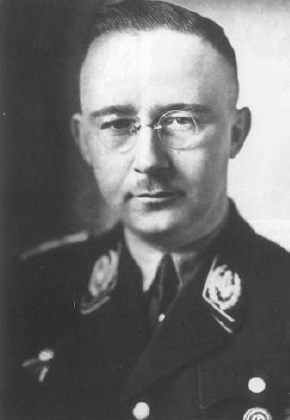
Heinrich Himmler (1900-1945) Reichsfuhrer-SS,
chief of the German Police
(The Trustees of the Imperial War Museum, London)
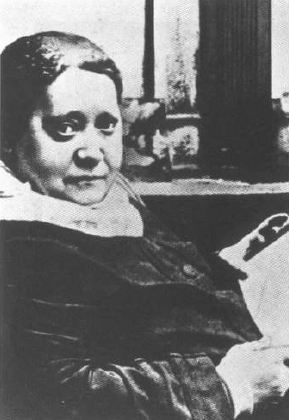
Madame Blavatsky, (1831-1891)
founder of the Theosophical Society (Fortean
Picture Library)
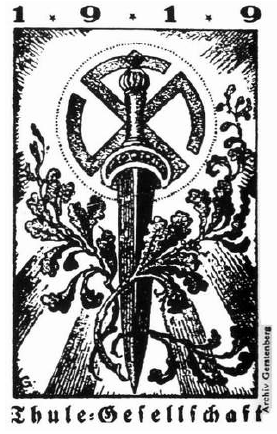
Thule Society emblem (David Hatcher Childress)
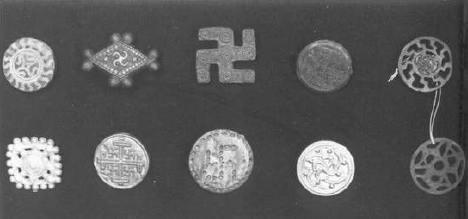
Plastic swastika badges.
Each
depicts the use of the swastika in antiquity - a subject dear to Himmler's
heart (Robin Lumsden)
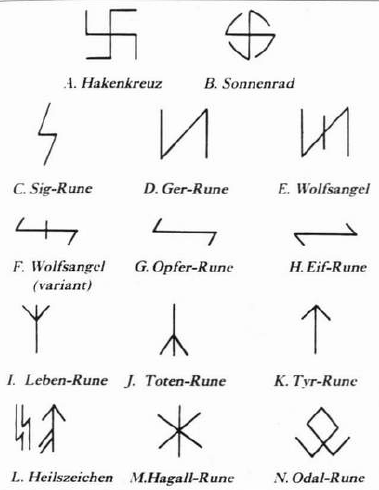
Runic symbols used by the SS. For a complete guide to
runic symbols as used by the SS,
see Robin Lumsden's Himmler's Black Order
1923-1945 (Sutton Publishing)
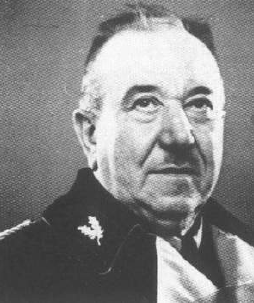
Karl-Maria Wiligut-Weisthor in 1936
(Kreismuseum Wewelsburg)

Various views of the 'totenkopf or death's head ring, displaying runic
symbols
(Robin Lumsden)
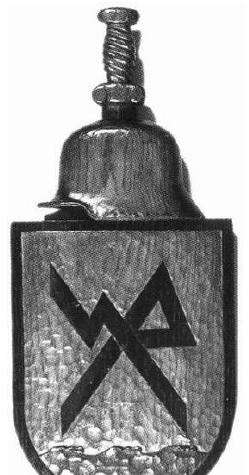
This oak shield, carved with runic symbols, was typical of the wall
decorations hung in Wewelsberg castle
(Robin Lumsden)
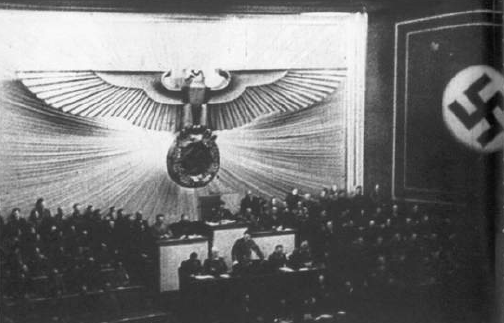
Hitler speaking in the Reichstag
(The Trustees of the Imperial War Museum,
London)

A Nazi rally, 1936
(The Trustees of the Imperial War Museum, London)
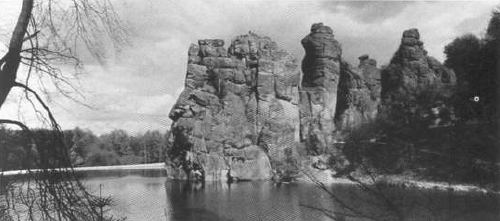
The Externsteine in the Teutoburger Wald near Paderborn, Germany - a place of
mythological significance in Aryan history
(Karl Aarsleff/Fortean Picture
Library)
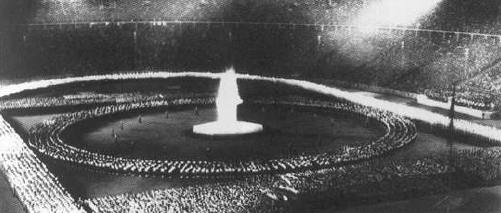
A pseudo-pagan solstice celebration 1937, sponsored by the SS and held in
the Berlin Olympic Stadium
(Robin Lumsden)

Hitler in 'blood banner' ceremony. A feature of Nazi rallies was the
dedication of new standards.
This was always done by Hitler who held a
corner of the banner in his hand and joined this with the banner that was to
be dedicated.
He then shook hands with the senior officer of the escort, in
this case a Standarten-fuhrer of the S.A.
(The Trustees of the Imperial War
Museum, London)
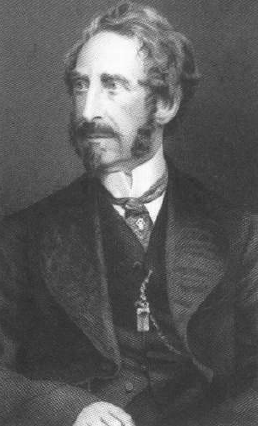
Edward G.E.L. Bulwer-Lytton (1803-1873), author of
The Coming Race
(Mary
Evans Picture Library)
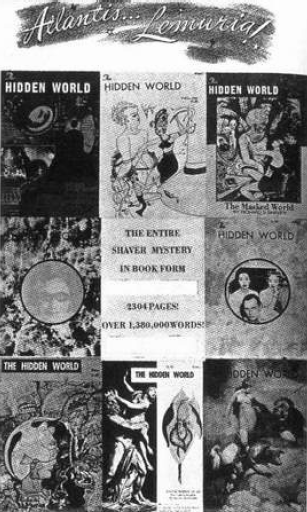
Pulp science fiction writer Richard Shaver's Hidden World series
(Fortean
Picture Library)
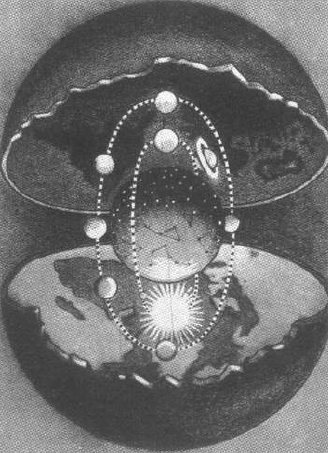
Map of the mythical realms of Agharta and Shambala
(SpiritWeb)
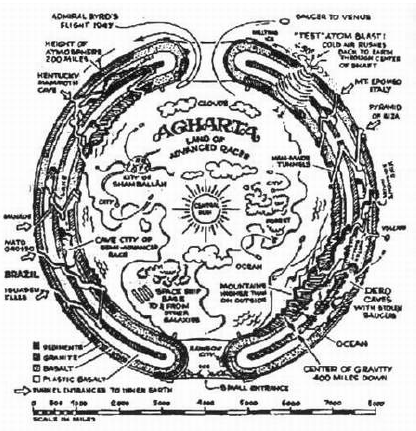
German scientist Neupert's illustration of the 'hollow earth' 1935
(Mary
Evans Picture Library)
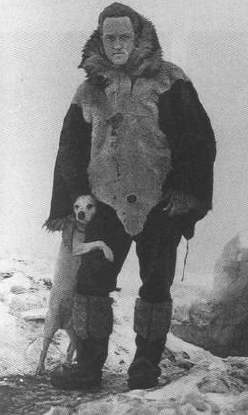
Rear Admiral Richard Evelyn Byrd (1888-1957)
flew Over the South Pole on 29
November 1929 with three companions and Igloo his pet terrier
(Fortean
Picture Library)

Emblem of the Deutsche Antarktische Expedition 1938-9
(David Hatcher
Childress)
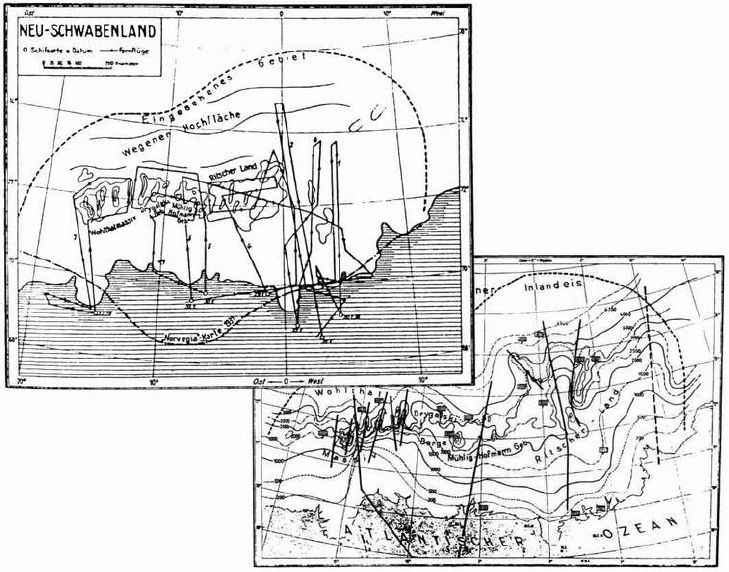
Antarctic topography as surveyed by the Nazis
(David Hatcher
Childress)
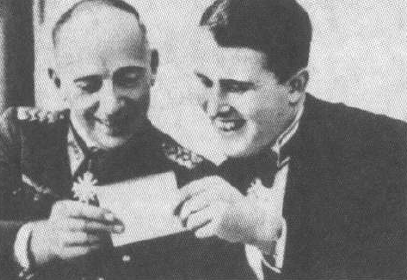
Nazi Germany's wartime rocket chief Walter Dornberger seen here on the left
with Werner von Braun in 1944
(David Hatcher Childress)
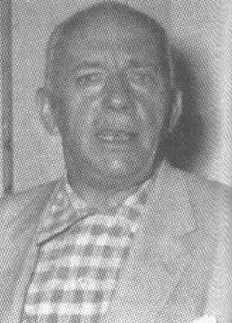
Dornberger in 1954 after entering the United States under Project Paperclip.
He went on to emerge as senior executive of the Bell Aerosystems Division of
Textron
(David Hatcher Childress)
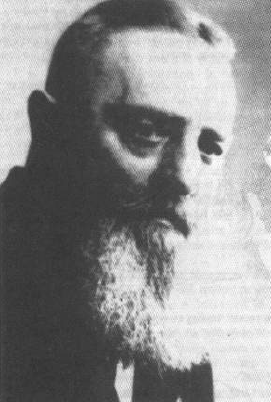
Viktor Schauberger (1885-1958), Austrian
inventor of a number of 'flying discs'
who supposedly worked on a top secret
project in Texas after the war.
On his death bed he said over and over:
'They took everything from me. I don't even own myself.'
(David Hatcher
Childress)
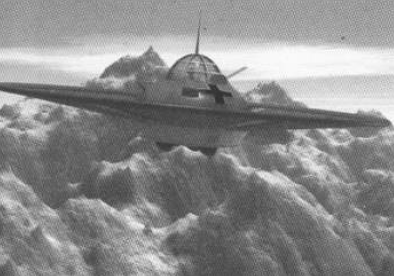
Artist's impression of a Schriever flying disc
(© Lee Krystek
1998)
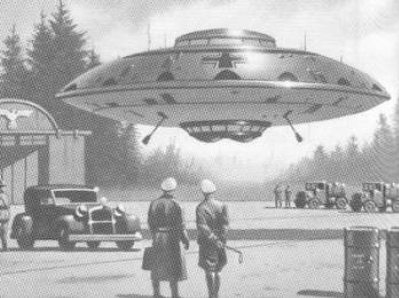
Artist's impression of the Bellonzo Schriever-Miethe Disc
(® James H.
Nichols 1991)
After a disastrous business partnership with a confidence trickster named
G.R. Clements, during which they sold useless, waterlogged land to people
wishing to grow crops, Siegmeister fled the United States and the legal
action with which he was threatened, and went to Equador in 1941.
There he
met a friend, John Wierlo, who had moved from America the previous year, and
together they conceived the idea of creating a new Utopia and a 'super-race'
somewhere in the jungles in the east of the country. The 'Adam' of this
scheme would be Wierlo (by all accounts an impressive example of manhood);
the 'Eve' would be a 24-year-old woman named Marian Windish, a hermit who
had apparently lived for two years in the Equadorian jungle. (65)
The new
Utopia, however, was not to be: Wierlo later claimed that he had no
intention of creating a super-race, and it also transpired that Marian
Windish was already married.
Wierlo also accused Siegmeister of faking an
ability to walk on water by means of a series of supports just below the
surface. So outlandish were Siegmeister's claims of miraculous powers and
meetings with Tibetan masters on Equadorian mountains (many of which
appeared in the American press) that he was forbidden from using the US Mail
Service and deported by the Equadorian Immigration Department. (66)
Upon his return to the United States, Siegmeister, now using the name Dr
Robert Raymond, continued his promotion of a healthy diet by selling health
foods and two books he had written, entitled Are You Being Poisoned lay the
Food You Eat? and Super-Health thru Organic Super-Foods. He then began
travelling again throughout South America, selling his books through mail
order, now under the name Dr Uriel Adriana, AB, MA, PhD. When his mother
died in 1955, leaving him a substantial amount of money, he moved to Brazil
and bought a large plot of land with the intention of continuing his efforts
to create a super-race.
In his 1955 book Escape From Destruction, which he
again wrote under the pseudonym Raymond Bernard, he warned of a coming
nuclear war, from which a few people would be saved by extraterrestrials who
would take them to Mars. (67)
While in Brazil, Siegmeister came across an odd book entitled From the
Subterranean World to the Sky by one O. C. Huguenin who seems to have held a
high position in the Brazilian Theosophical Society. In common with Shaver,
Huguenin claimed that the UFOs were the handiwork of an ancient civilization
(Huguenin claimed they were the Atlanteans) that had built them 12,000 years
ago, just before the destruction of their continent.
Some Atlanteans escaped
the cataclysm by taking their craft through the Polar openings and
reestablishing their fabulous civilisation in the inner Earth. The reason
UFOs were being seen by so many surface dwellers was that the Atlanteans
were concerned at humanity's use of nuclear energy (concerns that were also
attributed to the so-called 'Space Brothers' by the American contactees of
the 1950s - see Chapter Eight).
At this time, two Theosophist friends of Huguenin, Commander Paulo Strauss
and Professor Henrique de Souza, were also actively promoting in Brazil the
idea of the hollow Earth: Strauss by lecturing widely about a UFO base
called Agharta, and de Souza by claiming that he was in contact with the
Atlanteans. (68) Siegmeister also claimed to have met an Atlantean woman
(who looked like an eighteen-year-old, but who was actually 70) at the
Theosophical Society Headquarters in Sao Lourenco.
At one of these meetings,
de Souza told Siegmeister that Brazil contained a number of tunnels leading
down to the inner Earth (Childress notes that one of the tunnels was
supposed to be in the Roncador Mountains of the Matto Grosso, the region in
which the famous explorer Colonel Percy Fawcett disappeared in 1925). (69)
According to de Souza, Fawcett was still alive and well in an Atlantean
city, although he was prevented from leaving in case the surface dwellers
forced him to reveal its whereabouts. Although he claimed to have made many
trips into the Roncador Mountains, Siegmeister never found any of the tunnel
entrances.
When some friends in America sent him a copy of Ray Palmer's journal Flying
Saucers, containing articles about Rear Admiral Byrd's flights and the
Hollow Earth Theory, Siegmeister went into creative overdrive, writing
Agharta, The Subterranean World and Flying Saucers from the Earth's
Interior.
At this time, 1960, Siegmeister received a letter from one
Ottmar
Kaub, who was a member of an organization called UFO World Research based in
St Louis, Missouri. Kaub was writing on behalf of the organization's leader,
Dr. George Marlo, who claimed to have visited the inner Earth on board a
UFO, and who wished to live at Siegmeister's Brazilian colony. Dr Marlo
claimed to know two beings called Sol-Mar and Zola, who lived in a city
called Masars II, underneath South Africa. Sol-Mar and Zola described the
inner Earth as a paradise with a perfect climate, giant fruits, beautiful
birds with 30-foot wingspans, and where the people grew to over 12 feet
tall. (70)
For the next few years, Marlo tantalized Siegmeister with promises of a
meeting with Sol-Mar and Zola - meetings that were always unavoidably
postponed for various reasons. Eventually, Siegmeister realized that Marlo
was lying about his contacts with the Inner Earthers and decided to continue
his researches alone.
In 1964, he managed to find a New York publisher for his last book, The
Hollow Earth, which was largely a rewrite of Flying Saucers from the Earth's
Interior and also borrowed heavily from Reed, Gardner and Giannini. The book
sold well, but unfortunately Siegmeister did not live to enjoy its success:
he died of pneumonia in 1965.
Although The Hollow Earth contains a great
deal of material from earlier writers, it is distinguished by its lengthy
treatment of the idea that the governments of the world are well aware of
the 'fact' that UFOs are spacecraft, and that they come from the inner Earth
(it was one of the first books to pay serious attention to this idea). In
addition, Siegmeister was one of the first writers to suggest that the US
and Soviet Governments were secret allies in the face of the potential
threat posed by the Inner Earth civilization, a claim that has become an
integral part of modern conspiracy theory. (71)
Siegmeister's greatest legacy, however, must be the identification of Brazil
as the most significant location in the mythology of the hollow Earth. Not
only is that country a hot spot for UFO activity and encounters with
apparent 'aliens', it also contains possibly more subterranean tunnel
networks and entrances to the inner Earth than any other country. Before
moving on, we may cast a glance at some of the reports that have recently
been coming out of Brazil concerning some rather unusual discoveries.
For
instance, the Brazilian organization Sociedade de Estudos Extrater-restres
(SOCEX) has spent the last few years investigating claims that an elaborate
tunnel network exists in the mountains of Santa Catarina and Parana States,
particularly around the town of Joinville about 190 miles south-west of Sao
Paulo (which, oddly enough, was Siegmeister's base of operations in Brazil).
(72)
In another SOCEX report, two men entered a tunnel near the city of Ponta
Grossa, 250 miles south-west of Sao Paulo, in which they discovered a
staircase leading further underground. Descending the staircase, the men
found themselves in a small underground city, where they remained for five
days with its 50 inhabitants. Many people have reported UFOs in the area,
and some say they have heard singing, the voices apparently coming from
underground. (73)
While these stories may be taken with a large grain of salt (their
protagonists are invariably referred to by pseudonyms or just initials), the
claim that Brazil, and indeed the rest of South America, is an important
centre of UFO activity and of the belief in powerful subterranean
civilizations is of considerable significance to the present study.
In South
America we find the nexus of the ideas we shall be discussing in the last
two chapters of this book: firstly, that by the end of the Second World War
the Nazis had begun to develop aircraft and weapons systems radically in
advance of anything in use elsewhere at the time; and secondly, that Nazism
as a potent political force did not cease to exist with the defeat of the
Third Reich but continues in one or more secret locations, still exerting a
powerful influence on world events.
As with most aspects of what may broadly be termed 'the paranormal', the
concepts of Nazi occultism and genuine Nazi occult power (the former a
verifiable historical fact, the latter an unsafe extrapolation based on
rumor and hearsay) have merged into one another to such a degree that a
clear line of dichotomy between the two has become virtually impossible to
define.
This will become especially apparent as we conclude this chapter on
the hollow Earth and subterranean civilizations with a look at the tunnel
system that is said to exist beneath South America. While legends of tunnels
beneath South America have existed ever since the Spanish conquest of the
continent, referring to the mysterious places where the Incas were said to
have hidden most of their gold, there is some evidence for their actual
existence.
Some modern explorers even claim to have visited them.
Chief among these is David Hatcher Childress, who has written many books on
the more unorthodox aspects of archaeology and who offers an account of one
such adventure he undertook in his fascinating and informative study of the
Shaver Mystery and the
Hollow Earth Theory, Lost Continents and the Hollow
Earth. Childress describes how he followed a lead provided in a letter sent
to him by one of his South American readers, named Marli, who described an
opening leading to a tunnel system near the small mountain town of Sao Tome
das Lettres, north of Sao Paulo.
Childress travelled to the town with Marli, and in a local restaurant they
listened, together with about twenty others, to the owner as he told a
strange story of a man-made tunnel extending far into the earth.
Marli
translated the restaurant owner's Portuguese:
'The Brazilian army went into the tunnel one time to find out where it ends.
After travelling for four days through the tunnel the team of Army explorers
eventually came to a large room deep underground. This room had four
openings to four tunnels, each going in a different direction. They had
arrived in the room by one of the tunnels.
'They stayed in the room for some time, using it as their base, and
attempted to explore each of the other three tunnels, but after following
each for some time, turned back to the large room. Eventually they returned
to the surface, here at Sao Tome das Lettres.
'... [T]here is a man here in town who claims to know the tunnel and claims
that he has been many weeks inside the tunnel. This man claims that the
tunnel goes all the way to Peru, to Machu Picchu in the Andes. This man
claims that he went completely under South America, across Brazil and to
Machu Picchu.' (74)
The restaurant owner went on to tell how he himself had encountered a
strange man near the tunnel entrance one morning. The man was dressed in
traditional Andean Indian clothes, and was extremely tall, approximately
seven feet. As soon as he saw the restaurant owner, the man walked away
without saying anything.
Childress goes on to report that the following morning he, Marli and a
fellow explorer named Carl Hart went to the tunnel entrance with the
intention of exploring as far as they could.
He continues:
I was amazed at this ancient feat of engineering. We were descending down
into the earth in a wide, gradually sloping tunnel that was dug into a red,
clay-type dirt. It was not the smooth, laser-cut rock walls that Erich von
Daniken had claimed to have seen in Equador in his book Gold of the Gods,
but it was just as incredible.
It wouldn't have taken some space-age device to make this tunnel, just
simple tools; yet, it was clearly a colossal undertaking. Why would anyone
build such a tunnel? Was it an ancient mine that went deep into the earth,
searching for an elusive vein of gold or merely red clay for the long-gone
ceramic kilns? Was it an elaborate escape tunnel used in the horrific wars
that were said to have been fought in South America - and around the world -
in the distant past?
Or was it some bizarre subterranean road that linked up
with other tunnels in the Andes and ultimately could be used to journey
safely to such places as Machu Picchu, Cuzco or the Atacama Desert? (75)
In the event, the answers to these questions evaded the small party: after
an hour, they arrived at a point where the floor dropped approximately one
meter, and decided that this was a convenient place to turn back, since the
tunnel seemed to continue endlessly on, and they were not equipped for a
lengthy exploration.
Although the group did not encounter any fabulous
wonders of the subterranean realm, the very existence of the tunnel proves
that the legends associated with South America have some basis in fact.
Back to Contents
























